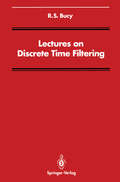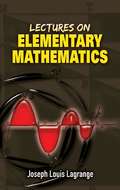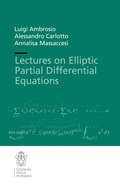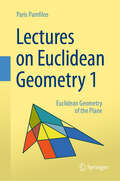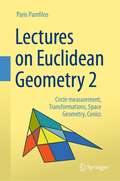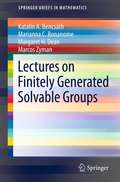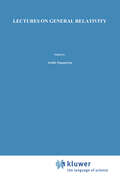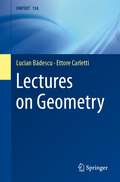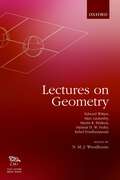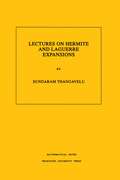- Table View
- List View
Lectures on Discrete Geometry (Graduate Texts in Mathematics #212)
by Jiri MatousekThe main topics in this introductory text to discrete geometry include basics on convex sets, convex polytopes and hyperplane arrangements, combinatorial complexity of geometric configurations, intersection patterns and transversals of convex sets, geometric Ramsey-type results, and embeddings of finite metric spaces into normed spaces. In each area, the text explains several key results and methods.
Lectures on Discrete Time Filtering (Signal Processing and Digital Filtering)
by R.S. BucyThe theory of linear discrete time filtering started with a paper by Kol mogorov in 1941. He addressed the problem for stationary random se quences and introduced the idea of the innovations process, which is a useful tool for the more general problems considered here. The reader may object and note that Gauss discovered least squares much earlier; however, I want to distinguish between the problem of parameter estimation, the Gauss problem, and that of Kolmogorov estimation of a process. This sep aration is of more than academic interest as the least squares problem leads to the normal equations, which are numerically ill conditioned, while the process estimation problem in the linear case with appropriate assumptions leads to uniformly asymptotically stable equations for the estimator and the gain. The conditions relate to controlability and observability and will be detailed in this volume. In the present volume, we present a series of lectures on linear and nonlinear sequential filtering theory. The theory is due to Kalman for the linear colored observation noise problem; in the case of white observation noise it is the analog of the continuous-time Kalman-Bucy theory. The discrete time filtering theory requires only modest mathematical tools in counterpoint to the continuous time theory and is aimed at a senior-level undergraduate course. The present book, organized by lectures, is actually based on a course that meets once a week for three hours, with each meeting constituting a lecture.
Lectures on Elementary Mathematics (Dover Books on Mathematics)
by Joseph Louis LagrangeOne of the eighteenth century's greatest mathematicians, Lagrange made significant contributions to all fields of analysis and number theory. He survived the French Revolution to deliver these lectures in 1795 at the École Normale, a training school for teachers. An exemplar among elementary expositions, Lagrange's talks feature both originality of thought and elegance of expression.The five lectures begin with discussions of arithmetic that focus on fractions and logarithms as well as theory and applications. Subsequent talks consider algebra, with emphasis on the resolution of equations of the third and fourth degree, the resolution of numerical equations, and the employment of curves in the solution of problems. Students, teachers, and others with an interest in mathematics will find this volume a unique reading book in mathematics, with fascinating historical and philosophical remarks by a distinguished mathematician.
Lectures on Elliptic Partial Differential Equations (Publications of the Scuola Normale Superiore #18)
by Luigi Ambrosio Alessandro Carlotto Annalisa MassaccesiThe book originates from the Elliptic PDE course given by the first author at the Scuola Normale Superiore in recent years. It covers the most classical aspects of the theory of Elliptic Partial Differential Equations and Calculus of Variations, including also more recent developments on partial regularity for systems and the theory of viscosity solutions.
Lectures on Euclidean Geometry - Volume 1: Euclidean Geometry of the Plane
by Paris PamfilosThis is a comprehensive two-volumes text on plane and space geometry, transformations and conics, using a synthetic approach. The first volume focuses on Euclidean Geometry of the plane, and the second volume on Circle measurement, Transformations, Space geometry, Conics.The book is based on lecture notes from more than 30 courses which have been taught over the last 25 years. Using a synthetic approach, it discusses topics in Euclidean geometry ranging from the elementary (axioms and their first consequences), to the complex (the famous theorems of Pappus, Ptolemy, Euler, Steiner, Fermat, Morley, etc.). Through its coverage of a wealth of general and specialized subjects, it provides a comprehensive account of the theory, with chapters devoted to basic properties of simple planar and spatial shapes, transformations of the plane and space, and conic sections. As a result of repeated exposure of the material to students, it answers many frequently asked questions. Particular attention has been given to the didactic method; the text is accompanied by a plethora of figures (more than 2000) and exercises (more than 1400), most of them with solutions or expanded hints. Each chapter also includes numerous references to alternative approaches and specialized literature. The book is mainly addressed to students in mathematics, physics, engineering, school teachers in these areas, as well as, amateurs and lovers of geometry. Offering a sound and self-sufficient basis for the study of any possible problem in Euclidean geometry, the book can be used to support lectures to the most advanced level, or for self-study.
Lectures on Euclidean Geometry - Volume 2: Circle measurement, Transformations, Space Geometry, Conics
by Paris PamfilosThis is a comprehensive two-volumes text on plane and space geometry, transformations and conics, using a synthetic approach. The first volume focuses on Euclidean Geometry of the plane, and the second volume on Circle measurement, Transformations, Space geometry, Conics. The book is based on lecture notes from more than 30 courses which have been taught over the last 25 years. Using a synthetic approach, it discusses topics in Euclidean geometry ranging from the elementary (axioms and their first consequences), to the complex (the famous theorems of Pappus, Ptolemy, Euler, Steiner, Fermat, Morley, etc.). Through its coverage of a wealth of general and specialized subjects, it provides a comprehensive account of the theory, with chapters devoted to basic properties of simple planar and spatial shapes, transformations of the plane and space, and conic sections. As a result of repeated exposure of the material to students, it answers many frequently asked questions. Particular attention has been given to the didactic method; the text is accompanied by a plethora of figures (more than 2000) and exercises (more than 1400), most of them with solutions or expanded hints. Each chapter also includes numerous references to alternative approaches and specialized literature. The book is mainly addressed to students in mathematics, physics, engineering, school teachers in these areas, as well as, amateurs and lovers of geometry. Offering a sound and self-sufficient basis for the study of any possible problem in Euclidean geometry, the book can be used to support lectures to the most advanced level, or for self-study.
Lectures on Factorization Homology, ∞-Categories, and Topological Field Theories (SpringerBriefs in Mathematical Physics #39)
by Hiro Lee TanakaThis book provides an informal and geodesic introduction to factorization homology, focusing on providing intuition through simple examples. Along the way, the reader is also introduced to modern ideas in homotopy theory and category theory, particularly as it relates to the use of infinity-categories. As with the original lectures, the text is meant to be a leisurely read suitable for advanced graduate students and interested researchers in topology and adjacent fields.
Lectures on Financial Mathematics: Discrete Asset Pricing (Synthesis Lectures on Mathematics & Statistics)
by Greg Anderson Alec KerchevalThis is a short book on the fundamental concepts of the no-arbitrage theory of pricing financial derivatives. Its scope is limited to the general discrete setting of models for which the set of possible states is finite and so is the set of possible trading times--this includes the popular binomial tree model. This setting has the advantage of being fairly general while not requiring a sophisticated understanding of analysis at the graduate level. Topics include understanding the several variants of "arbitrage", the fundamental theorems of asset pricing in terms of martingale measures, and applications to forwards and futures. The authors' motivation is to present the material in a way that clarifies as much as possible why the often confusing basic facts are true. Therefore the ideas are organized from a mathematical point of view with the emphasis on understanding exactly what is under the hood and how it works. Every effort is made to include complete explanations and proofs, and the reader is encouraged to work through the exercises throughout the book. The intended audience is students and other readers who have an undergraduate background in mathematics, including exposure to linear algebra, some advanced calculus, and basic probability. The book has been used in earlier forms with students in the MS program in Financial Mathematics at Florida State University, and is a suitable text for students at that level. Students who seek a second look at these topics may also find this book useful. Table of Contents: Overture: Single-Period Models / The General Discrete Model / The Fundamental Theorems of Asset Pricing / Forwards and Futures / Incomplete Markets
Lectures on Finitely Generated Solvable Groups (SpringerBriefs in Mathematics)
by Katalin A. Bencsath Marianna C. Bonanome Margaret H. Dean Marcos ZymanLectures on Finitely Generated Solvable Groups are based on the “Topics in Group Theory" course focused on finitely generated solvable groups that was given by Gilbert G. Baumslag at the Graduate School and University Center of the City University of New York. While knowledge about finitely generated nilpotent groups is extensive, much less is known about the more general class of solvable groups containing them. The study of finitely generated solvable groups involves many different threads; therefore these notes contain discussions on HNN extensions; amalgamated and wreath products; and other concepts from combinatorial group theory as well as commutative algebra. Along with Baumslag’s Embedding Theorem for Finitely Generated Metabelian Groups, two theorems of Bieri and Strebel are presented to provide a solid foundation for understanding the fascinating class of finitely generated solvable groups. Examples are also supplied, which help illuminate many of the key concepts contained in the notes. Requiring only a modest initial group theory background from graduate and post-graduate students, these notes provide a field guide to the class of finitely generated solvable groups from a combinatorial group theory perspective.
Lectures on Fluid Dynamics: A Particle Theorist’s View of Supersymmetric, Non-Abelian, Noncommutative Fluid Mechanics and d-Branes (CRM Series in Mathematical Physics)
by Roman JackiwExplains the motivation and reviewing the classical theory in a new form; Discusses conservation laws and Euler equations; For one-dimensional cases, the models presented are completely integrable
Lectures on Formal and Rigid Geometry (Lecture Notes in Mathematics #2105)
by Siegfried BoschThe aim of this work is to offer a concise and self-contained 'lecture-style' introduction to the theory of classical rigid geometry established by John Tate, together with the formal algebraic geometry approach launched by Michel Raynaud. These Lectures are now viewed commonly as an ideal means of learning advanced rigid geometry, regardless of the reader's level of background. Despite its parsimonious style, the presentation illustrates a number of key facts even more extensively than any other previous work.This Lecture Notes Volume is a revised and slightly expanded version of a preprint that appeared in 2005 at the University of Münster's Collaborative Research Center "Geometrical Structures in Mathematics".
Lectures on Formally Real Fields (Lecture Notes in Mathematics #1093)
by A. PrestelAbsolute values and their completions - like the p-adic number fields- play an important role in number theory. Krull's generalization of absolute values to valuations made applications in other branches of mathematics, such as algebraic geometry, possible. In valuation theory, the notion of a completion has to be replaced by that of the so-called Henselization. In this book, the theory of valuations as well as of Henselizations is developed. The presentation is based on the knowledge aquired in a standard graduate course in algebra. The last chapter presents three applications of the general theory -as to Artin's Conjecture on the p-adic number fields- that could not be obtained by the use of absolute values only.
Lectures on Fourier Integrals. (AM-42), Volume 42
by Salomon Bochner Morris Tenenbaum Harry PollardThe description for this book, Lectures on Fourier Integrals. (AM-42), Volume 42, will be forthcoming.
Lectures on Functional Analysis and the Lebesgue Integral (Universitext)
by Vilmos KomornikThis textbook, based on three series of lectures held by the author at the University of Strasbourg, presents functional analysis in a non-traditional way by generalizing elementary theorems of plane geometry to spaces of arbitrary dimension. This approach leads naturally to the basic notions and theorems. Most results are illustrated by the small ℓp spaces. The Lebesgue integral, meanwhile, is treated via the direct approach of Frigyes Riesz, whose constructive definition of measurable functions leads to optimal, clear-cut versions of the classical theorems of Fubini-Tonelli and Radon-Nikodým. Lectures on Functional Analysis and the Lebesgue Integral presents the most important topics for students, with short, elegant proofs. The exposition style follows the Hungarian mathematical tradition of Paul Erdős and others. The order of the first two parts, functional analysis and the Lebesgue integral, may be reversed. In the third and final part they are combined to study various spaces of continuous and integrable functions. Several beautiful, but almost forgotten, classical theorems are also included. Both undergraduate and graduate students in pure and applied mathematics, physics and engineering will find this textbook useful. Only basic topological notions and results are used and various simple but pertinent examples and exercises illustrate the usefulness and optimality of most theorems. Many of these examples are new or difficult to localize in the literature, and the original sources of most notions and results are indicated to help the reader understand the genesis and development of the field.
Lectures on Functor Homology (Progress in Mathematics #311)
by Vincent Franjou Antoine TouzéThis book features a series of lectures that explores three different fields in which functor homology (short for homological algebra in functor categories) has recently played a significant role. For each of these applications, the functor viewpoint provides both essential insights and new methods for tackling difficult mathematical problems.In the lectures by Aurélien Djament, polynomial functors appear as coefficients in the homology of infinite families of classical groups, e.g. general linear groups or symplectic groups, and their stabilization. Djament’s theorem states that this stable homology can be computed using only the homology with trivial coefficients and the manageable functor homology. The series includes an intriguing development of Scorichenko’s unpublished results.The lectures by Wilberd van der Kallen lead to the solution of the general cohomological finite generation problem, extending Hilbert’s fourteenth problem and its solution to the context of cohomology. The focus here is on the cohomology of algebraic groups, or rational cohomology, and the coefficients are Friedlander and Suslin’s strict polynomial functors, a conceptual form of modules over the Schur algebra.Roman Mikhailov’s lectures highlight topological invariants: homotopy and homology of topological spaces, through derived functors of polynomial functors. In this regard the functor framework makes better use of naturality, allowing it to reach calculations that remain beyond the grasp of classical algebraic topology.Lastly, Antoine Touzé’s introductory course on homological algebra makes the book accessible to graduate students new to the field. The links between functor homology and the three fields mentioned above offer compelling arguments for pushing the development of the functor viewpoint. The lectures in this book will provide readers with a feel for functors, and a valuable new perspective to apply to their favourite problems.
Lectures on Gaussian Processes (SpringerBriefs in Mathematics)
by Mikhail LifshitsGaussian processes can be viewed as a far-reaching infinite-dimensional extension of classical normal random variables. Their theory presents a powerful range of tools for probabilistic modelling in various academic and technical domains such as Statistics, Forecasting, Finance, Information Transmission, Machine Learning - to mention just a few. The objective of these Briefs is to present a quick and condensed treatment of the core theory that a reader must understand in order to make his own independent contributions. The primary intended readership are PhD/Masters students and researchers working in pure or applied mathematics. The first chapters introduce essentials of the classical theory of Gaussian processes and measures with the core notions of reproducing kernel, integral representation, isoperimetric property, large deviation principle. The brevity being a priority for teaching and learning purposes, certain technical details and proofs are omitted. The later chapters touch important recent issues not sufficiently reflected in the literature, such as small deviations, expansions, and quantization of processes. In university teaching, one can build a one-semester advanced course upon these Briefs.
Lectures on General Relativity
by A. PapapetrouThis book is an elaboration of lecture notes for the graduate course on General Rela tivity given by the author at Boston University in the spring semester of 1972. It is an introduction to the subject only, as the time available for the course was limited. The author of an introduction to General Relativity is faced from the beginning with the difficult task of choosing which material to include. A general criterion as sisting in this choice is provided by the didactic character of the book: Those chapters have to be included in priority, which will be most useful to the reader in enabling him to understand the methods used in General Relativity, the results obtained so far and possibly the problems still to be solved. This criterion is not sufficient to ensure a unique choice. General Relativity has developed to such a degree, that it is impossible to include in an introductory textbook of a reasonable length even a very condensed treatment of all important problems which have been discussed until now and the author is obliged to decide, in a more or less subjective manner, which of the more recent developments to omit. The following lines indicate by means of some examples the kind of choice made in this book.
Lectures on Geometric Variational Problems
by Seiki Nishikawa Richard SchoenIn this volume are collected notes of lectures delivered at the First In ternational Research Institute of the Mathematical Society of Japan. This conference, held at Tohoku University in July 1993, was devoted to geometry and global analysis. Subsequent to the conference, in answer to popular de mand from the participants, it was decided to publish the notes of the survey lectures. Written by the lecturers themselves, all experts in their respective fields, these notes are here presented in a single volume. It is hoped that they will provide a vivid account of the current research, from the introduc tory level up to and including the most recent results, and will indicate the direction to be taken by future researeh. This compilation begins with Jean-Pierre Bourguignon's notes entitled "An Introduction to Geometric Variational Problems," illustrating the gen eral framework of the field with many examples and providing the reader with a broad view of the current research. Following this, Kenji Fukaya's notes on "Geometry of Gauge Fields" are concerned with gauge theory and its applications to low-dimensional topology, without delving too deeply into technical detail. Special emphasis is placed on explaining the ideas of infi nite dimensional geometry that, in the literature, are often hidden behind rigorous formulations or technical arguments.
Lectures on Geometry (UNITEXT #158)
by Lucian Bădescu Ettore CarlettiThis is an introductory textbook on geometry (affine, Euclidean and projective) suitable for any undergraduate or first-year graduate course in mathematics and physics. In particular, several parts of the first ten chapters can be used in a course of linear algebra, affine and Euclidean geometry by students of some branches of engineering and computer science. Chapter 11 may be useful as an elementary introduction to algebraic geometry for advanced undergraduate and graduate students of mathematics. Chapters 12 and 13 may be a part of a course on non-Euclidean geometry for mathematics students. Chapter 13 may be of some interest for students of theoretical physics (Galilean and Einstein’s general relativity). It provides full proofs and includes many examples and exercises. The covered topics include vector spaces and quadratic forms, affine and projective spaces over an arbitrary field; Euclidean spaces; some synthetic affine, Euclidean and projective geometry; affine and projective hyperquadrics with coefficients in an arbitrary field of characteristic different from 2; Bézout’s theorem for curves of P^2 (K), where K is a fixed algebraically closed field of arbitrary characteristic; and Cayley-Klein geometries.
Lectures on Geometry (Clay Lecture Notes)
by Edward Witten Martin Bridson Helmut Hofer Marc Lackenby Rahul PandharipandeThis volume contains a collection of papers based on lectures delivered by distinguished mathematicians at Clay Mathematics Institute events over the past few years. It is intended to be the first in an occasional series of volumes of CMI lectures. Although not explicitly linked, the topics in this inaugural volume have a common flavour and a common appeal to all who are interested in recent developments in geometry. They are intended to be accessible to all who work in this general area, regardless of their own particular research interests.
Lectures on Geometry (Clay Lecture Notes)
by Edward Witten Helmut Hofer Martin Bridson Marc Lackenby Rahul PandharipandeThis volume contains a collection of papers based on lectures delivered by distinguished mathematicians at Clay Mathematics Institute events over the past few years. It is intended to be the first in an occasional series of volumes of CMI lectures. Although not explicitly linked, the topics in this inaugural volume have a common flavour and a common appeal to all who are interested in recent developments in geometry. They are intended to be accessible to all who work in this general area, regardless of their own particular research interests.
Lectures on Hermite and Laguerre Expansions. (Mathematical Notes #103)
by Sundaram ThangaveluThe interplay between analysis on Lie groups and the theory of special functions is well known. This monograph deals with the case of the Heisenberg group and the related expansions in terms of Hermite, special Hermite, and Laguerre functions. The main thrust of the book is to develop a concrete Littlewood-Paley-Stein theory for these expansions and use the theory to prove multiplier theorems. The questions of almost-everywhere and mean convergence of Bochner-Riesz means are also treated. Most of the results in this monograph appear for the first time in book form.
Lectures on Hermite and Laguerre Expansions. (MN-42), Volume 42
by Sundaram ThangaveluThe interplay between analysis on Lie groups and the theory of special functions is well known. This monograph deals with the case of the Heisenberg group and the related expansions in terms of Hermite, special Hermite, and Laguerre functions. The main thrust of the book is to develop a concrete Littlewood-Paley-Stein theory for these expansions and use the theory to prove multiplier theorems. The questions of almost-everywhere and mean convergence of Bochner-Riesz means are also treated. Most of the results in this monograph appear for the first time in book form.
Lectures on Hermitian-Einstein Metrics for Stable Bundles and Kähler-Einstein Metrics: Delivered at the German Mathematical Society Seminar in Düsseldorf in June, 1986 (Oberwolfach Seminars #8)
by Y.-T. SiuThese notes are based on the lectures I delivered at the German Mathematical Society Seminar in Schloss Michkeln in DUsseldorf in June. 1986 on Hermitian-Einstein metrics for stable bundles and Kahler-Einstein metrics. The purpose of these notes is to present to the reader the state-of-the-art results in the simplest and the most comprehensible form using (at least from my own subjective viewpoint) the most natural approach. The presentation in these notes is reasonably self-contained and prerequisi tes are kept to a minimum. Most steps in the estimates are reduced as much as possible to the most basic procedures such as integration by parts and the maximum principle. When less basic procedures are used such as the Sobolev and Calderon-Zygmund inequalities and the interior Schauder estimates. references are given for the reader to look them up. A considerable amount of heuristic and intuitive discussions are included to explain why certain steps are used or certain notions introduced. The inclusion of such discussions makes the style of the presentation at some places more conversational than what is usually expected of rigorous mathemtical prese"ntations. For the problems of Hermi tian-Einstein metrics for stable bundles and Kahler-Einstein metrics one can use either the continuity method or the heat equation method. These two methods are so very intimately related that in many cases the relationship betwen them borders on equivalence. What counts most is the a. priori estimates. The kind of scaffolding one hangs the a.

